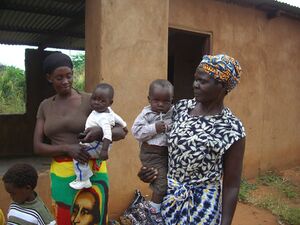Seeds for Life in Zambia: Difference between revisions
(Created page with "{{Project |Description=Providing seeds, fresh water and solar-powered water reticulation systems for schools and communities in Zambia. Thousands of rural children must walk several miles each way to get to school, women draw water from rivers and streams. In October temperatures soar to over 40 degrees C (100 degrees F), and no rain has fallen since April, resulting in food supplies being depleted. Children walk to school without breakfast, relying on school feeding pro...") |
(Added geo ID) |
||
| Line 31: | Line 31: | ||
File:pict_large.jpg|Seeds for Life in Zambia,File:ph_10448_36743.jpg|Ground nuts,File:ph_10448_36744.jpg|Widow and grandmother with infants,File:ph_10448_36745.jpg|Young girls need education,File:ph_10448_36746.jpg|Grandmother supporting five orphans,File:ph_10448_36747.jpg|Providing food for the family,File:ph_10448_36748.jpg|Education for girls,File:ph_10448_61963.jpg|Dried Maize,File:ph_10448_69805.jpg|Feeding Program - Mukuni Secondary School,File:ph_10448_69806.jpg|Feeding Program - N'gandu Basic School,File:ph_10448_79507.jpg|Maize is the staple diet for Zambia children | File:pict_large.jpg|Seeds for Life in Zambia,File:ph_10448_36743.jpg|Ground nuts,File:ph_10448_36744.jpg|Widow and grandmother with infants,File:ph_10448_36745.jpg|Young girls need education,File:ph_10448_36746.jpg|Grandmother supporting five orphans,File:ph_10448_36747.jpg|Providing food for the family,File:ph_10448_36748.jpg|Education for girls,File:ph_10448_61963.jpg|Dried Maize,File:ph_10448_69805.jpg|Feeding Program - Mukuni Secondary School,File:ph_10448_69806.jpg|Feeding Program - N'gandu Basic School,File:ph_10448_79507.jpg|Maize is the staple diet for Zambia children | ||
]] | ]] | ||
|coordinate=,}} | |coordinate=, | ||
|geo_id=895949}} | |||
Revision as of 13:26, 18 May 2023
| Organization | The Butterfly Tree |
|---|---|
| Region | Zambia |
| Website | Website |
| N/A | |
| N/A | |
| ProjectLeader | Jane Kaye-Bailey |
| Linked Problems & Solutions
|
|---|
Providing seeds, fresh water and solar-powered water reticulation systems for schools and communities in Zambia. Thousands of rural children must walk several miles each way to get to school, women draw water from rivers and streams. In October temperatures soar to over 40 degrees C (100 degrees F), and no rain has fallen since April, resulting in food supplies being depleted. Children walk to school without breakfast, relying on school feeding program, which could be their only meal of the day.
Challenge
Rural communities in Zambia have been decimated by the HIV/AIDS pandemic, leaving 1.2 million orphaned children. Poverty is extreme, with two thirds of the population living on less than $2 a day.
Long-Term Impact
The long-term effect will be very beneficial. Schools producing their own food will alleviate hunger, which can lead to malnutrition and poor health, this and the provision of safe water will provide sustainability. Boreholes and solar-powered water systems will supply everyone with water during the dry season when water is in short supply, especially in times of drought. The long-term impact is for the benefit of children, schools and the community at large.
References
- http://www.thebutterflytree.org.uk
- http://www.thebutterflytree.org.uk/pages/about/
- http://www.thebutterflytree.org.uk/pages/
- http://www.thebutterflytree.org.uk/pages/our-work/food/
- http://www.thebutterflytree.org.uk/pages/about/charity-history/
Additional Documentation
https://www.globalgiving.org//pfil/10448/projdoc.pdf
Project Gallery










